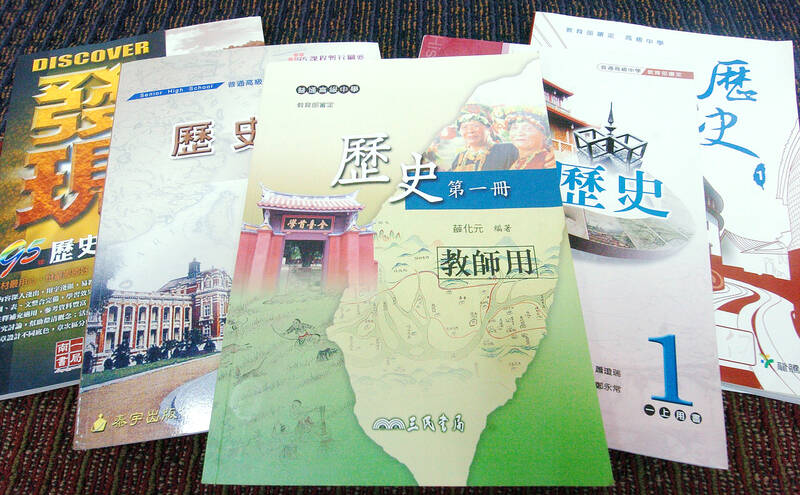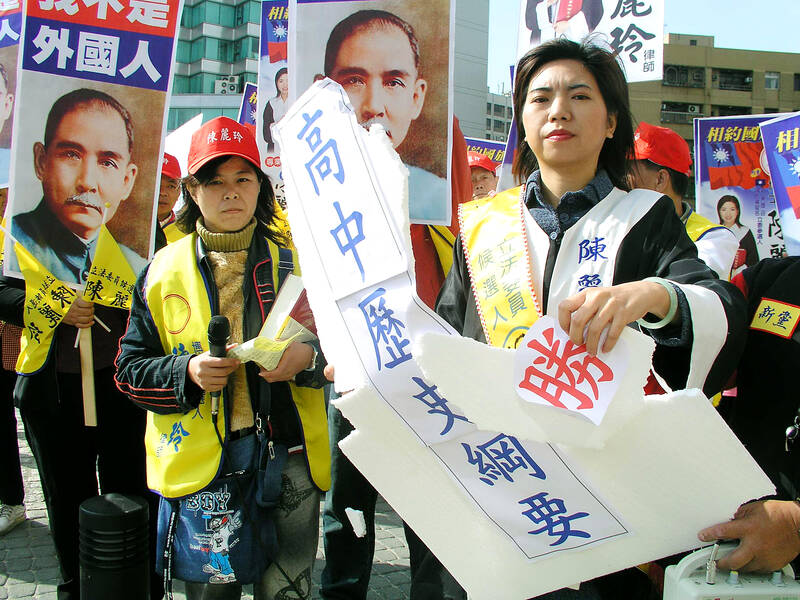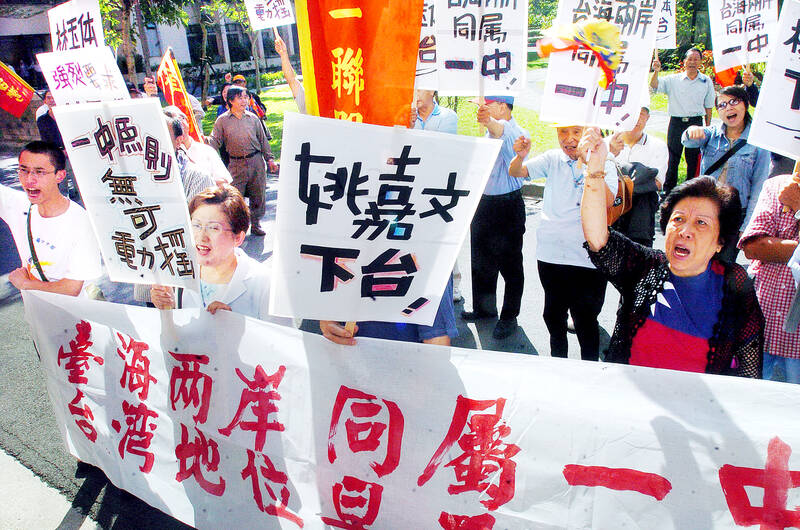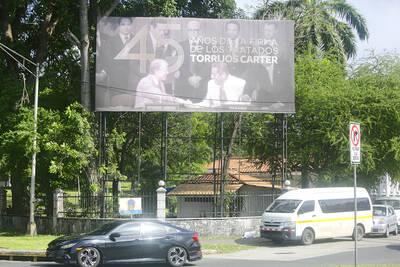NOV. 7 to NOV. 13
“The Democratic Progressive Party (DPP) has joined forces with the Chinese Communist Party to wipe out the Republic of China (ROC),” a Central Daily News (中央日報) headline read on Nov. 10, 2004.
“Spare our children! They won’t know what country they belong to,” another headline in the Chinese Nationalist Party (KMT) mouthpiece stated.

Photo: Tsung Chang-chin, Taipei Times
The reaction was in response to the proposed high school curriculum guidelines released a day earlier, in which Taiwanese history was to be taught as an individual subject for the first time.
Under the new guidelines, first-year students would take Taiwanese history the first semester, whereas the founding of the Republic of China (ROC) and its early years would be moved to Chinese history and taught the following semester. Second-year students would take world history, which included how international events related to Taiwan and China.
The opposition was not having it. “Chen [Shui-bian (陳水扁)] administration’s Taiwanese independence education makes great leap forward,” another Central Daily News headline read. It blasted the curriculum as “completely severing” Taiwan from the ROC, and criticized them for “negatively interpreting” the period between 1949 and 1987 as “authoritarian rule.”

Photo: Hsu Hui-ling, Taipei Times
“These historic perspectives are full of ideologies that will obfuscate and distort the students’ understanding of our national history,” it continued.
Then-KMT chairman Lien Chan (連戰) further said that the move is an act of turning one’s back on one’s ancestors, and will “wreck the country and bring ruin to the people.”
Then-education minister Tu Cheng-sheng (杜正勝) explained: “When Sun Yat-sen (孫逸仙) founded the ROC, Taiwan was still under Japanese occupation, therefore the founding of the ROC has been moved to Chinese history. This is completely reasonable and based on historic truth.”

Photo: Chen Tse-ming, Taipei Times
Perhaps the most divisive issue was the inclusion of the Treaty of San Francisco and the Cairo Declaration, which are often used to debate whether the ROC had the right to take over Taiwan after World War II. Tu explained that it does not detract from the fact that the ROC has ruled Taiwan since 1949, but opponents were adamant that the whole curriculum was an act of “de-ROC-ization” (去中華民國化) that only promotes hatred toward China.
More than a decade later, the fact that Taiwanese should first learn Taiwanese history is pretty much an accepted fact, but this shift did not come easily.
POST MARTIAL LAW
The Liberty Times (Taipei Times’ sister paper) columnist Hu Wen-hui (胡文輝) described the teaching of history during authoritarian rule as “pages of lies and exaggerations, streaming with bitter tears” in a Nov. 11, 2004 editorial.
“History textbooks then were used for the purpose of building up the image of the “savior of the nation’s peoples.” Repeated military defeats were “withdrawals,” corrupt, incompetent figures who lost their own country were “great men” and authoritarian tyranny was “benevolent rule.”
“After Taiwan’s democratization, these vestiges of authoritarianism should have been removed immediately, but due to the long-time oppression from the former autocrats and their absolute control over education, the overhauling of these history and geography textbooks have been especially difficult to undertake.”
According to the “Study on Controversies Surrounding High School History Curriculum Guidelines” (高中歷史課綱爭議之研究) by Lin Wei-che (林暐哲), the goals of history education during the Martial Law era were to propagate Sun’s Three Principles of the People, foster anti-communist sentiment and encourage students to dedicate themselves to retaking China. Taiwan was just a temporary base for this goal, so the emphasis was almost entirely on China.
After the lifting of martial law in 1987, all high school textbooks were still government edited and produced, leading to the protests on April 10, 1994 calling for the liberalization and diversification of educational materials. Starting from 1999, private companies could create their own books and send them to the National Institute for Compilation and Translation for review.
ENDLESS REFORM
Minor changes were made to high school history textbooks after the lifting of martial law. In 1990, the 228 Incident, an anti-government uprising in 1947 that was brutally suppressed by the KMT, was mentioned for the first time, albeit briefly.
The government released an overhauled version in 1995, which employed more neutral, non-propaganda language. The proportion of Taiwan-related content was increased to about 20 percent, although it was still part of Chinese history. Even the Chinese history portions employed a more diverse perspective, moving away from a purely Han-centric viewpoint.
In this version, Taiwan was still primarily a base to retake and reunify China, the Three Principles of the People were still emphasized, Sun Yat-sen and Chiang Kai-shek (蔣介石) were referred to with honorifics with a blank space preceding their name to denote respect and the map of China still used the wildly inaccurate pre-1949 version that included Mongolia and nine northeastern provinces.
Shortly after the DPP took power in 2000, they put together a committee of scholars for curriculum reform. The central idea was Tu’s “concentric circle” proposal that he had been espousing for years, with Taiwan as the core, China in the middle layer and the world on the outside. The ratio of the three areas was set for 1:1:2.
Unification was no longer the sole goal. One textbook under the new guidelines stated that Taiwan’s future was uncertain, some wanted independence, some wanted unification, but most wanted to maintain the status quo. Chiang and Sun lost their honorifics, Japanese occupation was changed to Japanese rule and the map was updated to reflect reality.
Around this time, tensions were already high when then-president Chen Shui-bian said: “‘Our country’ does not refer to China (本國非中國).” In addition to the aforementioned controversies regarding the ROC’s existence, the Chinese history textbook’s omission of the Nanjing Massacre further fueled the ire of the opposition.
Conflict over the guidelines continued over the years and were modified several more times — during the Ma Ying-jeou (馬英九) years, the proportion of Chinese history was boosted in place of world history, but no matter what they did, Taiwanese history being taught on its own was set as stone.
Taiwan in Time, a column about Taiwan’s history that is published every Sunday, spotlights important or interesting events around the nation that either have anniversaries this week or are tied to current events.

April 14 to April 20 In March 1947, Sising Katadrepan urged the government to drop the “high mountain people” (高山族) designation for Indigenous Taiwanese and refer to them as “Taiwan people” (台灣族). He considered the term derogatory, arguing that it made them sound like animals. The Taiwan Provincial Government agreed to stop using the term, stating that Indigenous Taiwanese suffered all sorts of discrimination and oppression under the Japanese and were forced to live in the mountains as outsiders to society. Now, under the new regime, they would be seen as equals, thus they should be henceforth

Last week, the the National Immigration Agency (NIA) told the legislature that more than 10,000 naturalized Taiwanese citizens from the People’s Republic of China (PRC) risked having their citizenship revoked if they failed to provide proof that they had renounced their Chinese household registration within the next three months. Renunciation is required under the Act Governing Relations Between the People of the Taiwan Area and the Mainland Area (臺灣地區與大陸地區人民關係條例), as amended in 2004, though it was only a legal requirement after 2000. Prior to that, it had been only an administrative requirement since the Nationality Act (國籍法) was established in

Three big changes have transformed the landscape of Taiwan’s local patronage factions: Increasing Democratic Progressive Party (DPP) involvement, rising new factions and the Chinese Nationalist Party’s (KMT) significantly weakened control. GREEN FACTIONS It is said that “south of the Zhuoshui River (濁水溪), there is no blue-green divide,” meaning that from Yunlin County south there is no difference between KMT and DPP politicians. This is not always true, but there is more than a grain of truth to it. Traditionally, DPP factions are viewed as national entities, with their primary function to secure plum positions in the party and government. This is not unusual

US President Donald Trump’s bid to take back control of the Panama Canal has put his counterpart Jose Raul Mulino in a difficult position and revived fears in the Central American country that US military bases will return. After Trump vowed to reclaim the interoceanic waterway from Chinese influence, US Defense Secretary Pete Hegseth signed an agreement with the Mulino administration last week for the US to deploy troops in areas adjacent to the canal. For more than two decades, after handing over control of the strategically vital waterway to Panama in 1999 and dismantling the bases that protected it, Washington has